India
 From Conservapedia
From Conservapedia | भारत गणराज्य Bhārat Gaharājya | |
|---|---|
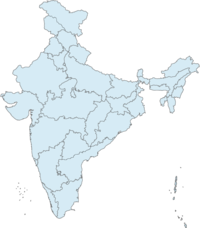 | |
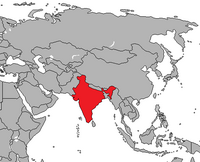 | |
 |
 |
| Flag | Coat of Arms |
| Capital | New Delhi |
| Government | Federal Republic |
| Language | [[Hindi, English]] (official) |
| President | Ram Nath Kovind |
| Prime minister | Narendra Modi |
| Area | 3,287,590 sq mi |
| Population | 1,380,000,000 (2020) |
| GDP | $2,590,000,000,000 (2020) |
| GDP per capita | $2,174 (2020) |
| Currency | rupee |
The Republic of India(Hindi:हिंदुस्तान Hindustan) is a massive social democratic nation located in South Asia with a population of 1.42 billion people - the most of any country in the world.[1] It spans from the Himalayas in the north to the Indian Ocean. It borders Afghanistan, Tajikistan,[2]Tibet, East Turkestan, Pakistan, Bangladesh, Nepal, Bhutan and Myanmar. India is the 7th largest country in the world in terms of area and second most populous country (standing at around 1.4 billion according to 2021 estimate), only behind China.
India is far more conservative than China, and the vast majority of Indians practice Hinduism, a religion which emphasizes family values, education, and tradition. The belief in reincarnation in Hinduism gives primacy to the future rather than the past, in contrast with Chinese religions.
Founded on August 15, 1947, India was known as the Union of India until it re-declared itself a democratic republic, using the name Republic of India. Though India is the world's third-largest economy in terms of purchasing power parity, and the fifth-largest economy in terms of nominal GDP, it has high levels of poverty, illiteracy, corruption and crime. However, poverty, illiteracy, corruption, and crime are declining dramatically, due to government reforms.
Contents
- 1 Etymology
- 2 People
- 3 Religions
- 3.1 Overview
- 3.2 Hinduism in India
- 3.3 Buddhism in India
- 3.4 Jainism in India
- 3.5 Sikhism in India
- 3.6 Other Religions in India
- 3.7 Religious Persecution
- 4 Government
- 5 Principal Government Officials
- 5.1 Politics
- 6 Foreign Relations
- 6.1 United States
- 7 Bilateral and Regional Relations
- 7.1 Tense relations with Pakistan
- 7.2 Relations with China
- 7.3 Russia
- 7.4 South Asian Association for Regional Cooperation (SAARC)
- 8 Defense
- 8.1 Indian Army
- 8.2 Indian Navy
- 8.3 Indian Air Force
- 9 Economy
- 9.1 Economic History
- 9.2 General overview
- 9.3 Agriculture
- 9.4 Industry
- 9.5 Education
- 10 History
- 11 Further reading
- 11.1 Guides
- 12 References
- 13 See also
Etymology[edit]
The original name of India prior to European colonialism was Hindustan. The word Hindustan traces its origins back to the Brihaspati Agama where its says "Starting from Himalaya up to Indu waters is this God created country called Hindustan."[3]
People[edit]
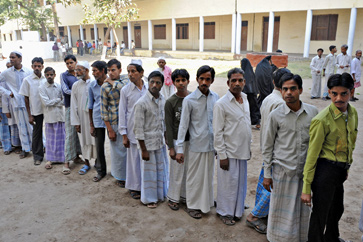
Although India occupies only 2.4% of the world's land area, it supports over 15% of the world's population; only China has a larger population. India's median age is 25, one of the youngest among large economies. About 70% live in more than 550,000 villages, and the remainder in more than 200 towns and cities. Over the thousands of years of its history, India has been invaded from the Iranian plateau, Central Asia, Arabia, Afghanistan, and the West; Indian people and culture have absorbed and modified these influences to produce a remarkable racial and cultural synthesis.
Religion, caste, and language are major determinants of social and political organization in India today. However, with more job opportunities in the private sector and better chances of upward social mobility, India has begun a quiet social transformation in this area. The government has recognized 18 official languages;[4] Hindi, the national language, is the most widely spoken, although English is a national lingua franca. Although 81% of its people are Hindu, India also is the home of more than 138 million Muslims—one of the world's largest Muslim populations. The population also includes Christians, Sikhs, Jains, Buddhists, and Parsis.
The Hindu caste system reflects Indian occupational and socially defined hierarchies. Ancient Sanskrit sources divide society into four major categories, priests (Brahmin), warriors (Kshatriya), traders-merchants (Vaishya) and farmers/laborers (Shudra). Although these categories are understood throughout India, they describe reality only in the most general terms. They omit, for example, the tribes and those once known as "untouchables." In reality, Indian society is divided into thousands of jatis—local, endogamous groups based on occupation—and organized hierarchically according to complex ideas of purity and pollution. Discrimination based on caste is officially illegal, but remains prevalent, especially in rural areas. Nevertheless, the government has made strong efforts to minimize the importance of caste through active affirmative action and social policies. Moreover, caste has been diluted if not subsumed in the economically prosperous and heterogeneous cities, where an increasing percentage of India's population lives. In the countryside, expanding education, land reform and economic opportunity through access to information, communication, transport, and credit have lessened the harshest elements of the caste system.
Religions[edit]
Overview[edit]
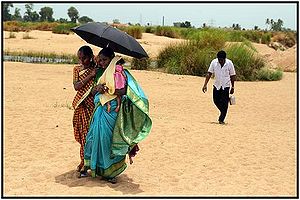
India has over 900 million Hindus, 150 millions Muslims, 25 million Christians and 20 million Sikhs among the many religious groups that make up the country[5] including communities of Jains, Buddhists, and Bahai.
India is the region where four major world religions were founded:
- Hinduism
- Buddhism
- Jainism
- Sikhism
Today, Hinduism and Buddhism are the world's third- and fourth-largest religions respectively, after Christianity and Islam, with a collective 1.4 billion followers.
Hinduism in India[edit]
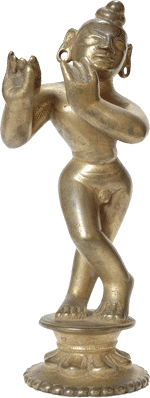
Hinduism as it is identified today has existed in India for over 4000 years; in the past it had spread to the rest of South-East Asia and Indonesia, although Hinduism is practiced outside India today only in the island of Bali.
The beliefs and practices of the pre-classical era (1500–500BC) are called the "historical Vedic religion". Modern Hinduism grew out of the Vedas,a large corpus of texts originating in Ancient India. They form the oldest layer of Sanskrit literature and the oldest sacred texts of Hinduism, the oldest of which is the Rigveda, dated to 1700–1100BC. The Vedas center on worship of deities such as Indra, Varuna and Agni, and on the Soma ritual. They performed fire-sacrifices, called yajña and chanted Vedic mantras but did not build temples or icons. The oldest Vedic traditions exhibit strong similarities to Zoroastrianism and with other Indo-European religions. During the Epic and Puranic periods, the earliest versions of the epic poems Ramayana and Mahabharata were written roughly from 500–100BC, although these were orally transmitted for centuries prior to this period. The epics contain mythological stories about the rulers and wars of ancient India, and are interspersed with religious and philosophical treatises. The later Puranas recount tales about devas and devis, their interactions with humans and their battles against demons.
Buddhism in India[edit]
Buddhism originated in Eastern India in the 6th century B.C. and spread to the rest of Asia through individual and organized missionaries, although there are few practicing Buddhists left in India today.
Jainism in India[edit]
Jainism originated in Eastern India in the 6th century B.C. and spread to the rest of India; today they are mostly concentrated in the Southern and Western parts of the country.
Sikhism in India[edit]
Sikhism is a monotheistic religion that originated in India in the 16th century A.D.
Other Religions in India[edit]
Christianity arrived in India in the first century A.D., possibly through the travels of the Apostle Thomas, whose tomb in the Indian city of Chennai is a major pilgrimage site for Christians in India.
Islam arrived in the latter half of the 8th century A.D. as a consequence of both war and trade. It continued to spread with invasions, wars and forced conversions by Afghans and Turkic Mongols. They slowly integrated into the society and formed India's Islamic tradition. The Taj Mahal, India's national monument, was built by a Muslim emperor named Shah Jahan. Islam is practiced by around 13.4% of all Indians.
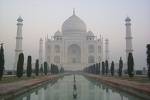
Although small in number, India does have a Jewish community. The first identifiably Jewish migrants arrived in India as the Bene Israel group. There is some debate as to the Jewishness of a possibly older group of Indians in the Northeastern part of the country called the Bnei Menashe.
Religious Persecution[edit]
While for many years India has been known as an area of the world where a melting pot of religions could be practiced freely, troubling and persistent persecution against Christians by the Hindu majority arose in the 1990s and has continued since that time. In October 2008, 38 Christians were killed and 30,000 fled from efforts of Hindu nationalist militants to force them to convert to Hinduism.[6]
There are also frequent attacks upon Indian Christians by Muslims in India, who make up a large proportion of the population. They subject the Indian Christian population to harassment and intimidation, particularly those who were previously Muslims. In 2006, a Muslim who converted to Christianity in the Indian state of Kashmir was shot dead by Jihadist militants.[7]
Government[edit]
According to its Constitution, India is a "sovereign, socialist, secular, democratic republic." Like the United States, India has a federal form of government. However, the central government in India has greater power in relation to its states, and has adopted a British-style parliamentary system.
The government exercises its broad administrative powers in the name of the president, whose duties are largely ceremonial. A special electoral college elects the president and vice president indirectly for 5-year terms. Their terms are staggered, and the vice president does not automatically become president following the death or removal from office of the president.
Real national executive power is centered in the Council of Ministers (Cabinet), led by the prime minister. The president appoints the prime minister, who is designated by legislators of the political party or coalition commanding a parliamentary majority in the Lok Sabha (lower house). The president then appoints subordinate ministers on the advice of the prime minister.
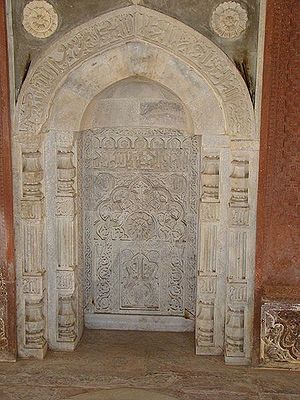
India's bicameral Parliament consists of the Rajya Sabha (Council of States) and the Lok Sabha (House of the People). The Council of Ministers is responsible to the Lok Sabha.
The legislatures of the states and union territories elect 233 members to the Rajya Sabha, and the president appoints another 12. The members of the Rajya Sabha serve 6-year terms, with one-third up for election every 2 years. The Lok Sabha consists of 545 members, who serve 5-year terms; 543 are directly elected, and two are appointed.
India's independent judicial system began under the British, and its concepts and procedures resemble those of Commonwealth countries. The Supreme Court consists of a chief justice and 25 other justices, all appointed by the president on the advice of the prime minister.
India has 28 states* and 7 union territories. At the state level, some legislatures are bicameral, patterned after the two houses of the national parliament. The states' chief ministers are responsible to the legislatures in the same way the prime minister is responsible to Parliament.
Each state also has a presidentially appointed governor, who may assume certain broad powers when directed by the central government. The central government exerts greater control over the union territories than over the states, although some territories have gained more power to administer their own affairs. Local governments in India have less autonomy than their counterparts in the United States. Some states are trying to revitalize the traditional village councils, or panchayats, to promote popular democratic participation at the village level, where much of the population still lives. Over half a million panchayats exist throughout India.
Principal Government Officials[edit]
- President—Pranab Mukherjee
- Vice President—Mohammed Hamid Ansari
- Prime Minister—Narendra Modi
- Home Minister—Rajnath Singh
- Minister of External Affairs—Shushma Swaraj
- Ambassador to the U.S.--Arun Singh
- Ambassador to the UN—Syed Akbaruddin
Politics[edit]
After the 2014 elections, the BJP, led by conservative Narendra Modi, won an absolute majority in the lower house, and after the 2017 state elections it received an absolute majority in the upper house as well.
The governing coalition led by the Indian National Congress sailed to a decisive victory in India's parliamentary elections in May 2009, adding 57 seats. The election gave a second term to prime minister Manmohan Singh, age 77, a soft-spoken economic reformer, and ended the prospect of political instability in the world's most populous democracy. The election confirmed that Sonia Gandhi, age 62, dominates the Congress Party. She is the Italian-born widow of the assassinated former prime minister Rajiv Gandhi and the daughter-in-law of the prime minister before him, Indira Gandhi, who was also assassinated. The Congress-led coalition built its near-majority with an appeal to the rural poor. During its first term, buoyed by robust economic growth, it used record government revenues to increase social spending, not just raising health and education budgets, but also starting an ambitious public works program in the countryside and a costly loan repayment waiver for farmers. Mrs. Gandhi won support by casting herself as a leader who relinquished power, turning down her party's appeals to become prime minister, first in 2004 and again this time. Instead, she chose the soft-spoken economist, Mr. Singh, and between them, they controlled the party and the government. She took care of the politics of keeping the coalition together, while he served as the chief executive who followed her advice.
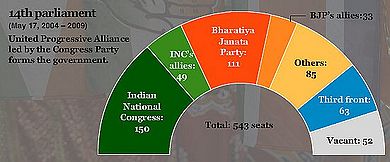
Emerging as the nation's single largest party in the April/May 2004 Lok Sabha election, Congress currently leads a coalition government under Prime Minister Manmohan Singh. Party President Sonia Gandhi was re-elected by the Party National Executive in May 2005. Also a Member of Parliament, she heads the Congress Lok Sabha delegation. Congress prides itself as a secular, left of center party, with a long history of political dominance. Although its performance in national elections had steadily declined during the last 12 years, its surprise victory in 2004 was a result of recruiting strong allies into the UPA, the anti-incumbency factor among voters, and its courtship of India's many poor, rural and Muslim voters. Congress political fortunes suffered badly in the 1990s, as many traditional supporters were lost to emerging regional and caste-based parties, such as the Bahujan Samaj Party and the Samajwadi Party, but have rebounded since its May 2004 ascension to power. It currently rules either directly or in coalition with its allies in 9 states. In November 2005, the Congress regained the Chief Ministership of Jammu and Kashmir state, under a power-sharing agreement.
The Bharatiya Janata Party (BJP), led by Rajnath Singh, holds the second-largest number of seats in the Lok Sabha. Former Prime Minister Atal Bihari Vajpayee serves as Chairman of the BJP Parliamentary Party, and former Deputy Prime Minister L.K. Advani is Leader of the Opposition. The Hindu-nationalist BJP draws its political strength mainly from the "Hindi Belt" in the northern and western regions of India.
The party holds power in the states of Gujarat, Madhya Pradesh, Rajasthan, Chhattisgarh, and Orissa—in coalition with the Biju Janata Dal. Popularly viewed as the party of the northern upper caste and trading communities, the BJP made strong inroads into lower castes in recent national and state assembly elections. The party must balance the competing interests of Hindu nationalists, (who advocate construction of a temple on a disputed site in Ayodhya, and other primarily religious issues), and center-right modernizers who see the BJP as a party of economic and political reform.
Recently, the Bhartiya Janata Party scored a major victory in the Lok Sabha Elections of 2014, with Narendra Modi becoming Prime Minister. Modi known to have made the Indian state of Gujarat become an economic powerhouse and one of the most developed state in India.
Four Communist and Marxist parties are united in a bloc called the "Left Front," which controls 57 parliamentary seats. The Left Front rules the states of West Bengal and Kerala. Although it has not joined the government, Left Front support provides the crucial seats necessary for the UPA to retain power in New Delhi; without its support, the UPA government would fall. It advocates a secular and Communist ideology and opposes many aspects of economic liberalization and globalization, resulting in dissonance with Prime Minister Singh's liberal economic approach.
Foreign Relations[edit]

- See also: Foreign relations of India
India's size, population, and strategic location give it a prominent voice in international affairs, and its growing economic strength, military prowess, and scientific and technical capacity give it added weight. The end of the Cold War dramatically affected Indian foreign policy. India remains a leader of the developing world and the Non-Aligned Movement (NAM). India is now strengthening its political and commercial ties with the United States, Japan, the European Union, Iran, China, and the Association of Southeast Asian Nations. India is an active member of the South Asian Association for Regional Cooperation (SAARC).
Always an active member of the United Nations, India now seeks a permanent seat on the UN Security Council. India has a long tradition of participating in UN peacekeeping operations.
United States[edit]
In September 2022 the Biden regime approved a $450 million F-16 fighter jet fleet maintenance programme to Pakistan,[8] reversing the decision of the previous Trump administration to suspend military aid to Islamabad for providing safe havens for the Afghan Taliban and the Haqqani network. Foreign Minister S. Jaishankar rejected the logic that the F-16 sustainment package approved by the Biden regime for Pakistan was to fight terrorism. Jaishankar said that everybody knows where and against whom F-16 fighter jets are used, an indirect reference that Pakistan uses them against India. “You are not fooling anybody by saying these things,” Jaishankar said in response to a question during an interaction with Indian-Americans.
Bilateral and Regional Relations[edit]
Tense relations with Pakistan[edit]
India and Pakistan have been locked in a very tense rivalry since the partition of the subcontinent upon achieving independence from Great Britain in 1947. The principal source of contention has been Kashmir, whose Hindu Maharaja at that time chose to join India, although a majority of his subjects were Muslim. India maintains that his decision and subsequent elections in Kashmir have made it an integral part of India. This dispute triggered wars between the two countries in 1947 and 1965 and provoked the Kargil conflict in 1999.
Pakistan and India fought a war in December 1971 following a political crisis in what was then East Pakistan and the flight of millions of Bengali refugees to India. The brief conflict left the situation largely unchanged in the west, where the two armies reached an impasse, but a decisive Indian victory in the east resulted in the creation of Bangladesh.

Since the 1971 war, Pakistan and India have made slow progress toward normalization of relations. In July 1972, Indian Prime Minister Indira Gandhi and Pakistani President Zulfikar Ali Bhutto met in the Indian hill station of Simla. They signed an agreement by which India would return all personnel and captured territory in the west and the two countries would "settle their differences by peaceful means through bilateral negotiations." Diplomatic and trade relations were re-established in 1976.
The 1979 Soviet invasion of Afghanistan caused new strains between India and Pakistan. Pakistan supported the Afghan resistance, while India implicitly supported the Soviet occupation. In the following eight years, India voiced increasing concern over Pakistani arms purchases, U.S. military aid to Pakistan, and Pakistan's nuclear weapons program. In an effort to curtail tensions, the two countries formed a joint commission. In December 1988, Prime Ministers Rajiv Gandhi and Benazir Bhutto concluded a pact not to attack each other's nuclear facilities and initiated agreements on cultural exchanges and civil aviation.
In 1997, high-level Indo-Pakistani talks resumed after a three-year pause. The Prime Ministers of India and Pakistan met twice, and the foreign secretaries conducted three rounds of talks. In June 1997 at Lahore, the foreign secretaries identified eight "outstanding issues" around which continuing talks would be focused. The dispute over the status of Jammu and Kashmir, an issue since partition, remains the major stumbling block in their dialogue. India maintains that the entire former princely state is an integral part of the Indian union, while Pakistan insists upon the implementation of UN resolutions calling for self-determination for the people of the state.
In September 1997, the talks broke down over the structure of how to deal with the issues of Kashmir and peace and security. Pakistan advocated that separate working groups treat each issue. India responded that the two issues be taken up along with six others on a simultaneous basis. In May 1998 India, and then Pakistan, conducted nuclear tests. Attempts to restart dialogue between the two nations were given a major boost by the February 1999 meeting of both Prime Ministers in Lahore and their signing of three agreements. These efforts were stalled by the intrusion of Pakistani-backed forces into Indian-held territory near Kargil in May 1999 (that nearly turned into full-scale war), and by the military coup in Pakistan that overturned the Nawaz Sharif government in October the same year. In July 2001, Mr. Vajpayee and General Pervez Musharraf, leader of Pakistan after the coup, met in Agra, but talks ended after two days without result.
After an attack on the Indian Parliament in December 2001, India-Pakistan relations cooled further as India accused Pakistan of involvement. Tensions increased, fueled by killings in Jammu and Kashmir, peaking in a troop buildup by both sides in early 2002.
Prime Minister Vajpayee's April 18, 2003 speech in Srinagar (Kashmir) revived bilateral efforts to normalize relations. In November 2003, Prime Minister Vajpayee and President Musharraf agreed to a ceasefire, which still holds, along the Line-of-Control in Jammu and Kashmir. After a series of confidence building measures, Prime Minister Vajpayee and President Musharraf met on the sidelines of the January 2004 SAARC summit in Islamabad and agreed to commence a Composite Dialogue addressing outstanding issues between India and Pakistan, including Kashmir. The UPA government has continued the Composite Dialogue with Pakistan.
In February 2004, India and Pakistan agreed to restart the "2+6" Composite Dialogue formula, which provides for talks on Peace and Security and Jammu and Kashmir, followed by technical and Secretary-level discussions on six other bilateral disputes: Siachen Glacier, Wuller Barrage/Tulbul Navigation Project, Sir Creek estuary, Terrorism and Drug Trafficking, Economic and Commercial cooperation, and the Promotion of Friendly Exchanges in various fields. The Foreign Secretary talks resumed in November 2006, after a three-month delay following the July 11, 2006 terrorist bombings in Mumbai. The meeting generated modest progress, with the two sides agreeing to establish a joint mechanism on counter-terrorism and agreeing to a follow-on meeting in February 2007. The restart of the Composite Dialogue process is especially significant, given the almost six years that transpired since the two sides agreed to this formula in 1997–98.
Following the October 2005 earthquake in Kashmir, the two governments coordinated relief efforts and opened access points along the Line-of-Control to allow relief supplies to flow from India to Pakistan and to allow Kashmiris from both sides to visit one another.
Relations with China[edit]
In June 2020 troops from the Peoples Liberation Army (PLA) and India clashed in the Galwan Valley.[9] The battle was fought with rocks, batons, and barbed wire-wrapped clubs. A 1996 agreement banned the use of guns and explosives along the disputed line of control. India reported 20 of their soldiers were killed, whereas the Peoples Republic of China (PRC) did not report any of its deaths. Indian media and the Russian news agency TASS reported that as many as 45 PLA soldiers may have been killed.[10] Over the following 12 months the PLA increased its troop strength along the border from 15,000 to 50,000 by July 2021, and moved advanced surface-to-air missiles including its HQ-9 system, which is similar to Russia’s S-300 and America’s Patriot missile.[11]
Ladakh was not the only Himalayan hotspot. There is a Chinese encroachment in India's Sikkim as well as incursions in neighboring Bhutan and Nepal.[12]
Beijing's campaign against India has been multifaceted. Cleo Paskal of the Foundation for Defense of Democracies said, "Since June of last year [2020], there was a China-attributed attack on the Mumbai electric grid, Chinese-linked Maoist terrorists killed another 20 Indian security forces, and we witnessed a destructive attack on an iPhone parts-manufacturing plant that looks like part of a Beijing political warfare operation to discourage the shifting of supply chains to India." Paskal explains, "The breadth and depth of the Communist Party's aggressive unrestricted warfare against India leads one to think there are no barriers to Beijing's malign behavior."
China has changed the definition of "warfare," and one of its instruments is disease. If SARS-CoV-2, the pathogen causing COVID-19, did not start out as a biological weapon, Chinese Communist Party leaders turned it into one, by lying about contagiousness and pressuring other countries to take disease-ridden arrivals from China.[13]
Russia[edit]
The collapse of the Soviet Union in 1991 and the emergence of the Commonwealth of Independent States (CIS) had major repercussions for Indian foreign policy. India's substantial trade with the region plummeted after the Soviet collapse and has yet to recover. Longstanding military supply relationships were similarly disrupted due to questions over financing. Russia nonetheless remains India's largest supplier of military systems and spare parts.
Russia and India have not renewed the 1971 Indo-Soviet Peace and Friendship Treaty and follow what both describe as a more pragmatic, less ideological relationship. The visit of Russian President Boris Yeltsin to India in January 1993 helped cement this new relationship. The pace of high-level visits has since increased, as has discussion of major defense purchases. UPA leader Sonia Gandhi and Prime Minister Singh visited Russia in July 2005. President Vladimir Putin traveled to India in January 2007 to attend an Indo-Russia Summit and was the guest of honor at India's Republic Day celebrations.
South Asian Association for Regional Cooperation (SAARC)[edit]
Certain aspects of India's relations within the subcontinent are conducted through the South Asian Association for Regional Cooperation (SAARC). Its members are Afghanistan, Bangladesh, Bhutan, India, Maldives, Nepal, Pakistan, and Sri Lanka, with the People's Republic of China, Iran, Japan, European Union, Republic of Korea, and the U.S. as observers. Established in 1985, SAARC encourages cooperation in agriculture, rural development, science and technology, culture, health, population control, narcotics, and terrorism.
SAARC has intentionally stressed these "core issues" and avoided those which could prove divisive, although political dialogue is often conducted on the margins of SAARC meetings. In 1993, India and its SAARC partners signed an agreement gradually to lower tariffs within the region. Forward movement in SAARC had slowed because of tension between India and Pakistan, and the SAARC summit scheduled for 1999 was not held until January 2002. In addition, to boost the process of normalizing India's relationship with Pakistan, the January 2004 SAARC summit in Islamabad produced an agreement to establish a South Asia Free Trade Area (SAFTA). All the member governments have ratified SAFTA, which was slated to come into force on January 1, 2006, with a series of graduated tariff cuts through 2015. As of December 2006, however, the FTA partners were still negotiating sensitive product lists, rules of origin, and technical assistance. India hosted the 2007 SAARC summit, which called for greater regional cooperation on trade, environmental, social, and counterterrorism issues.
Defense[edit]
The supreme command of the Indian armed forces is vested in the President of India. Policies concerning India's defense, and the armed forces as a whole, are formulated and confirmed by the Cabinet.
Indian Army[edit]
The Indian Army numbers over 1.1 million strong and fields 34 divisions. Its primary task is to safeguard the territorial integrity of the country against external threats. The Army has been heavily committed in the recent past to counterterrorism operations in Jammu and Kashmir, as well as the in the Northeast. Its current modernization program focuses on obtaining equipment to be used in combating terror. The Army often provides aid to civil authorities and assists the government in organizing relief operations.
[edit]
The Indian Navy is by far the most capable navy in the region. The Navy's primary missions are the defense of India and of India's vital sea lines of communication. India relies on the sea for 90% of its oil and natural gas and over 90% of its foreign trade. The Navy currently operates one aircraft carrier with two on order, 14 submarines, and 15 major surface combatants. It is capable of projecting power within the Indian Ocean basin and occasionally operates in the South China Sea, the Mediterranean Sea and the Arabian Gulf. Fleet introduction of the Brahmos cruise missile and the possible lease of nuclear submarines from Russia will add significantly to the Indian Navy's flexibility and striking power.
Although small, the Indian Coast Guard has been expanding rapidly in recent years. Indian Navy officers typically fill top Coast Guard positions to ensure coordination between the two services. India's Coast Guard is responsible for control of India's huge exclusive economic zone.
Indian Air Force[edit]
The Indian Air Force is becoming a 21st-century force through modernization, new tactics and the acquisition of modern aircraft, such as the SU-30MKI, a new advanced jet trainer (BAE Hawk) and the indigenously produced advanced light helicopter (Dhruv). In June 2007, the Indian Government announced intentions to release a request for proposals for 126 multi-role combat aircraft for the Indian Air Force.
Economy[edit]
The economy of India, measured in USD exchange-rate terms, is the seventh-largest in the world, with a GDP of around $3 trillion as of 2020. India recorded a GDP growth rate of 9.1% for the fiscal year 2007–2008 which makes its growth the second fastest among emerging economies in the world, after China.[14] At this rate of sustained growth many economists forecast that India would, over the coming decades, have a more pronounced economic effect on the world stage. Despite this phenomenal rate of growth, India's large population has an estimated per capita income of $2,563, measured by PPP, and $941, measured in nominal terms as of 2007
Economic History[edit]
In 1960, India was the tenth-largest economy, with a $35 billion GDP.[15] In 1965, India kept the 10th place, with a $55 billion GDP. India only went to $65 billion in 1970, still being 10th. In 1975, India got bumped down to 12th by Brazil and Spain, with a $100 billion GDP. In 1980, Argentina, Mexico, and Netherlands bumped India, with a $190 billion GDP, to 14th. In 1985, India got $240 billion, this time getting to 14th, because of Argentina's crashing economy. In 1990, India, with a $325 billion GDP, went to 13th, bumping down the Netherlands. In 1995, India had a $366.7 billion GDP, but got bumped by South Korea to 14th. In 2000, the $475 billion economy, which is India, got to 13th place, bumping down Russia's declining economy. In 2005, India climbed to $833 billion, bumped down Brazil and Mexico, thus climbing to 11th. In 2010, India had a $1.725 billion GDP, and got to 9th, bumping down Canada, South Korea, and Spain, but being bumped down by Russia. In 2015, India hit the $2 trillion mark, and ultimately reaching $2.1 trillion, becoming the seventh-largest economy, bumping down Italy and Brazil. In 2020, India bumped down European powers the United Kingdom and France, and, with its $3 trillion GDP, India became the fifth-largest economy. In 2025, India is expected to have a $5 trillion GDP, and would become the fourth-largest economy, surpassing Europe's largest economy, Germany. If projections come true, India could become the third-largest economy, and Asia's second-largest economy, with a $8 trillion GDP, in 2030.
General overview[edit]
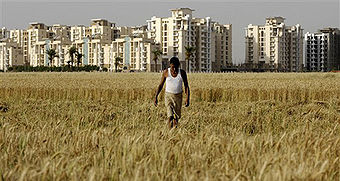
India's population is estimated at more than 1.1 billion and is growing at 1.3% a year. It has the world's 5th largest economy—and the third largest in Asia behind Japan and China—with total GDP of around $3 trillion ($3,000 billion). Services, industry, and agriculture account for 55%, 27%, and 18% of GDP respectively. Nearly two-thirds of the population depends on agriculture for its livelihood. 700 million Indians live on $2 per day or less, but there is a large and growing middle class of 325-350 million with disposable income for consumer goods.
India is continuing to move forward with market-oriented economic reforms that began in 1991. Recent reforms include liberalized foreign investment and exchange regimes, industrial decontrol, significant reductions in tariffs and other trade barriers, reform and modernization of the financial sector, significant adjustments in government monetary and fiscal policies, and safeguarding intellectual property rights.
Real GDP growth for the fiscal year ending March 31, 2007 was 9.4%, up from 9.0% growth in the previous year. Growth for the year ending March 31, 2008 is expected to be between 8.5 and 9.0%. Foreign portfolio and direct investment inflows have risen significantly in recent years. They have contributed to $255 billion in foreign exchange reserves by June 2007. Government receipts from privatization were about $3 billion in fiscal year 2003–2004, but the privatization program has stalled since then.
Economic growth is constrained by inadequate infrastructure, a cumbersome bureaucracy, corruption, labor market rigidities, regulatory and foreign investment controls, the "reservation" of key products for small-scale industries, and high (although declining) fiscal deficits. The outlook for further trade liberalization is mixed. India eliminated quotas on 1,420 consumer imports in 2002 and has incrementally lowered non-agricultural customs duties in recent successive budgets. However, the tax structure is complex, with compounding effects of various taxes.
The United States is India's largest trading partner. Bilateral trade in 2006 was $32 billion. Principal U.S. exports are diagnostic or lab reagents, aircraft and parts, advanced machinery, cotton, fertilizers, ferrous waste/scrap metal, and computer hardware. Major U.S. imports from India include textiles and ready-made garments, Internet-enabled services, agricultural and related products, gems and jewelry, leather products, and chemicals.
The rapidly growing software sector is boosting service exports and modernizing India's economy. Software exports crossed $28 billion in FY 2006–2007, while business process outsourcing (BPO) revenues hit $8.3 billion in 2006–2007. Personal computer penetration is 14 per 1,000 persons. The cellular/mobile market surged to 140 million subscribers by November 2006. The country has 54 million cable TV customers.
The United States is India's largest investment partner, with a 13% share. India's total inflow of U.S. direct investment is estimated at more than $9 billion through 2006. Proposals for direct foreign investment are considered by the Foreign Investment Promotion Board and generally receive government approval. Automatic approvals are available for investments involving up to 100% foreign equity, depending on the kind of industry. Foreign investment is particularly sought after in power generation, telecommunications, ports, roads, petroleum exploration/processing, and mining.
India's external debt was $155 billion in 2006–2007, up from $126 billion in 2005–2006. Foreign assistance was approximately $3 billion in 2006–2007, with the United States providing about $126 million in development assistance. The World Bank plans to double aid to India to almost $3 billion a year, with focus on infrastructure, education, health, and rural livelihoods.
In 2016, India abolished larger banknotes in a move toward a Cashless society.
Agriculture[edit]
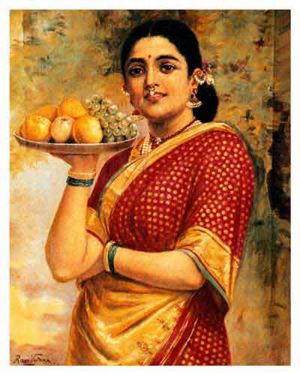
India has a cultivated area of 138 million hectares which almost equals that of the European Union. A lot of the land has good agriculture potential especially where water supplies are available. Arable farming, especially cereals is the main kind of farming. India, which has two thirds of its working population relying on the land to earn a living, desperately needs to improve agriculture production in order to develop its economy.
When India became independent from Britain in 1947 the Indian government recognized agriculture as a key area for economic development. Despite this there has been limited modernization of the sector. There hasn't been an effective land reform package introduced to redistribute land from wealthy landlords to landless peasants. In the 1990s almost half of rural families had plots of 0.5 hectares or no land at all, but a quarter of India's agricultural land was owned by five percent of rich landowning families. This has made it nearly impossible to mechanize and introduce modern farm practices.
The dominant type of farming throughout India is intensive Subsistence farming. It is used especially in rural areas with high population density, where people depend on being able to feed themselves. Rice is very important for this type of farming, especially in the Indus and Ganges flood plains. Other crops such as wheat and millet are grown in drier parts of peninsular India. Farming is a family affair, with all planting, flooding and harvesting done by hand. One of the reasons rural Indians have such large families is to provide free labour to help harvest crops. This adds to the pressure on India's service sector and India's agriculture sector to meet the demands of India's ever-growing population.
India is a country that has benefited from the Green revolution. This refers to the development and introduction of genetically modified, high yield varieties of staple crops, such as rice and wheat. These ‘miracle’ crops produce high yields and are resistant to disease and pests. Due to the Green revolution, India has managed to become a net exporter of food.
There is however some problems linked to the Green revolution. It depends on large inputs of chemical fertilizers and pesticides that may be costly and harmful to the soil in the long run. Labour is often replaced with machinery, so rural unemployment goes up and more people leave the land and go to towns, increasing rural-urban migration. A well-educated farm population and capital investment are needed. It only really benefits comparatively few, large-scale farmers; large numbers of small-scale farmers may not be able to benefit from the process.
For a large number of Indian farmers a better solution would be the introduction of more intermediate technology and a more effective programme of land reform. While the Green revolution has brought some positive results, the vast majority of India's rice farmers use traditional farm practices that depend heavily on the natural environment. The need to match food production to match India's growing population is a major concern for government.
Industry[edit]
When India became independent in 1947 it had a largely underdeveloped Industrial system, with textiles and food processing been the key industries in the country. Only two percent of the working population had been employed in industry, which was concentrated in the major cities; Bombay, Calcutta and Madras. On gaining independence the new government was determined to reduce India's dependence on imported goods and to promote greater wealth and employment throughout the country.
The size of India's population provided it a large home market and the country had some natural resources (coal and Iron) a large and cheap labour force and outputs from agriculture (cotton, Jute) Mineral resources encouraged the government to develop heavy industries, such as Iron and steel, shipbuilding and chemicals. Despite these advantages development was relatively slow and only benefited a few growth centers. In addition, by the 1980s, many heavy industries were in decline, Industrial policy has changed to emphasize Agri-industries, consumer goods industries and small craft industries, rural development (community based development and self-help schemes) and high technology industries.
Agri-industries would be advantageous to India in that it already employs a large number of people in the agricultural sector. The development of fertilizers, machinery and food processing benefits rural communities and helps in the modernization of India's agricultural system.
Consumer goods industries are more labor-intensive than large-scale heavy industries, so more jobs are created as a result. They also benefit from low labour costs and traditional skills, which make them more competitive in, export markets. E.g. jewellary, clothing, leather goods etc.
With more than 70% of India's population living in rural areas, jobs need to be taken to these people rather than encouraging migration to urban areas. This involves support for community development projects and self-help schemes that improve skills levels among the workforce.
High technology (Hi-tech) industries are attracted to India by the growing number of India's skilled workers (Which produces more university graduates than USA and Canada combined) low costs and improved communication systems. These high value industries add a modern face to Indian industry. Many major multinationals, such as IBM and Texas instruments, have located in India. Large numbers of locally owned companies have also set up to supply software components to western markets. (See Spin-off Effect)
Although the government has tried to spread industry across the country, this growing sector remains concentrated in a growing number of city regions. The most important are Calcutta, Bombay and Bangalore. Bangalore is known as ‘India’s silicon valley’ as a result of all the high-tech industries which have set up there.
Education[edit]
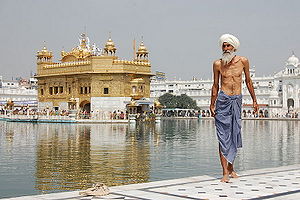
India has a large number of Universities, but the quality ranges from poor to medicore. The best students head to the U.S. or Britain. To cover this weakness, the government in July 2009 announced plans to expand the higher education budget by 40%, to $3.1-billion, for 2009–10.
The government in 2009 allotted an extra $435-million to the prestigious Indian Institutes of Technology and the National Institutes of Technology, and $170.5-million more to open 16 central universities in states that lack one. In keeping with its agenda of inclusive economic growth, the government has also announced interest-free loans for disadvantaged students to take technical and professional courses.
To increase India's college-going rate to 21% by 2017, Prime Minister Singh has announced plans to start five new Indian Institutes of Science Education and Research, eight new Indian Institutes of Technology, seven new Indian Institutes of Management, and 20 new Indian Institutes of Information Technology — thus doubling the number of top-tier institutions in the country. He also wants to set up 16 central universities, 14 “world class” universities, and almost 400 colleges.
History[edit]
See History of India
Further reading[edit]
- Cohen, Stephen P. India: Emerging Power (2002) excerpt and online search from Amazon.com
- Guha, Ramachandra. India After Gandhi: The History of the World's Largest Democracy (2008) excerpt and text search
- Nilekani, Nandan. Imagining India: The Idea of a Renewed Nation (2009) business in India excerpt and text search
- Panagariya, Arvind. India: The Emerging Giant (2008) 544 pp., The major recent history; for advanced readers. excerpt and text search
- Wolpert, Stanley. India (4th ed. 2009), 264pp; excellent overview and introduction excerpt and text search
Guides[edit]
- India (Lonely Planet Guide) by Sarina Singh et al. (2007) excerpt and text search
- India (Eyewitness Travel Guides by DK Publishing (2002) excerpt and text search)
- India - Culture Smart!: a quick guide to customs and etiquette by Nicki Grihault (2006) excerpt and text search
- The Rough Guide to India (2008) excerpt and text search
References[edit]
- ↑ https://www.downtoearth.org.in/video/governance/india-surpasses-china-to-become-most-populous-country-in-the-world-87257#:~:text=According to projections by the,now stands at 1.41 billion.
- ↑ http://www.jammu-kashmir.com/documents/harisingh47.html
- ↑ https://www.sanskritimagazine.com/indian-religions/hinduism/how-old-is-the-word-hindu/
- ↑ "In the early 1900s ... English was ascendant in India. ... It was the lingua franca to which Indians, who spoke more than a dozen distinct languages, turned when they did not otherwise understand one another." (The Man Who Knew Infinity, page 25 - Robert Kanigel)
- ↑ https://www.cia.gov/library/publications/the-world-factbook/geos/in.html
- ↑ http://www.msnbc.msn.com/id/27380721
- ↑ http://www.speroforum.com/site/article.asp?id=6705
- ↑ https://youtu.be/_3F6bVOyS68
- ↑ https://www.bbc.com/news/world-asia-53062484
- ↑ https://www.ndtv.com/india-news/china-says-5-military-officers-soldiers-killed-in-galwan-clash-with-india-report-2373770
- ↑ https://archive.is/6Hbvt
- ↑ https://www.bbc.com/news/world-asia-55793112
- ↑ https://www.gatestoneinstitute.org/17547/china-mobilizing-war
- ↑ "India Defies Turmoil With Growth of 8.8%", MarketWatch, May 31, 2007.
- ↑ https://en.wikipedia.org/wiki/List_of_countries_by_largest_historical_GDP
See also[edit]
- 99 year Lease(India)
- World History Lecture Three for more information on Ancient India.
- Anti-conversion legislation in India
- Oriental art
- Indian Painting
- Nuclear target structures
- Andaman and Nicobar Islands
- Opposition to the partition of India
| ||||||||
| |||||||||||
| Copyright Details | |
|---|---|
| License: | This work is in the Public Domain in the United States because it is a work of the United States Federal Government under the terms of Title 17, Chapter 1, Section 105 of the U.S. Code |
| Source: | File available from the United States Federal Government. |
| ||||||||||||||||||||
Categories: [India] [Indian History] [Buddhism] [Nuclear Defense]
↧ Download as ZWI file | Last modified: 02/23/2023 15:46:15 | 359 views
☰ Source: https://www.conservapedia.com/India | License: CC BY-SA 3.0
 ZWI signed:
ZWI signed: KSF
KSF